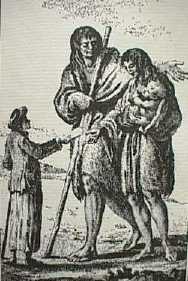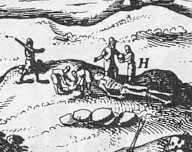The Patagonian Giants

"A sailor giving a Patagonian woman a piece of bread for her baby."—Detail from the frontispiece to A Voyage round the World, in his Majesty's ship the Dolphin, commanded by the Hon. Comm. Byron, 1767
The rumor soon gained widespread acceptance. Its credibility was helped by the fact that it built upon a large number of earlier accounts of Patagonian giants. For instance, Antonio Pigafetta, who sailed with Magellan in the 1520s, had written of an encounter with a race of South American giants. According to Pigafetta, Magellan referred to these giants as 'Patagons' because of their big feet, and so the southern tip of South America came to be known as Patagonia.
In 1578, Sir Francis Drake's ship chaplain, Francis Fletcher, also wrote a manuscript that described meeting very tall Patagonians. In the 1590s, Anthonie Knivet, who had sailed with Sir Thomas Cavendish, claimed that he had seen dead bodies in Patagonia measuring over twelve feet in length.
A long-running scientific debate also gave fuel to the rumors of a race of South American giants. The great French natural philosopher, Georges-Louis Leclerc, Comte de Buffon (1707-1788) had argued that animals and plants of the New World were small and degenerate in comparison to their European counterparts (this was before Europeans had done much exploring in the Americas). Buffon's opponents seized upon and promoted the rumors of South American giants in order to prove Buffon's theory of New World degeneracy wrong.

Detail from an engraving in the East and West Indian Mirror, 1619. It shows a group of Dutch sailors gazing down into the grave of a giant unearthed in South America in the year 1615.
The rumors of Patagonian giants were only definitively proven to be fictitious when the official account of Byron's voyage appeared in 1773. This account revealed that Byron had indeed encountered a tribe of Patagonians, but that the tallest among them measured only 6 feet 6 inches. In other words, they were tall, but not 12 foot giants. The tribe that Byron met was probably the Tehuelches, who were wiped out by the Rocca expedition in 1880.
References/Further Reading:
- Adams, Percy G. Travelers and Travel Liars: 1660-1800. University of California Press. 1962. Chapter Two.
| Main Page | Comments | Search |
Back to Gallery: 1700-1799 |